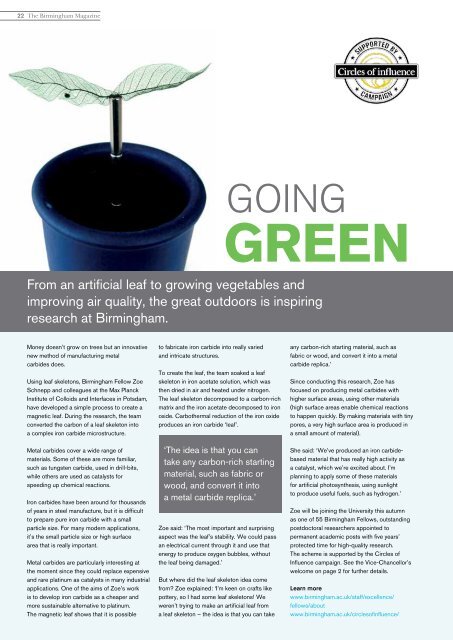BMag-2012 - University of Birmingham
BMag-2012 - University of Birmingham
BMag-2012 - University of Birmingham
You also want an ePaper? Increase the reach of your titles
YUMPU automatically turns print PDFs into web optimized ePapers that Google loves.
22 The <strong>Birmingham</strong> Magazine<br />
Money doesn’t grow on trees but an innovative<br />
new method <strong>of</strong> manufacturing metal<br />
carbides does.<br />
Using leaf skeletons, <strong>Birmingham</strong> Fellow Zoe<br />
Schnepp and colleagues at the Max Planck<br />
Institute <strong>of</strong> Colloids and Interfaces in Potsdam,<br />
have developed a simple process to create a<br />
magnetic leaf. During the research, the team<br />
converted the carbon <strong>of</strong> a leaf skeleton into<br />
a complex iron carbide microstructure.<br />
Metal carbides cover a wide range <strong>of</strong><br />
materials. Some <strong>of</strong> these are more familiar,<br />
such as tungsten carbide, used in drill-bits,<br />
while others are used as catalysts for<br />
speeding up chemical reactions.<br />
Iron carbides have been around for thousands<br />
<strong>of</strong> years in steel manufacture, but it is difficult<br />
to prepare pure iron carbide with a small<br />
particle size. For many modern applications,<br />
it’s the small particle size or high surface<br />
area that is really important.<br />
Metal carbides are particularly interesting at<br />
the moment since they could replace expensive<br />
and rare platinum as catalysts in many industrial<br />
applications. One <strong>of</strong> the aims <strong>of</strong> Zoe’s work<br />
is to develop iron carbide as a cheaper and<br />
more sustainable alternative to platinum.<br />
The magnetic leaf shows that it is possible<br />
to fabricate iron carbide into really varied<br />
and intricate structures.<br />
To create the leaf, the team soaked a leaf<br />
skeleton in iron acetate solution, which was<br />
then dried in air and heated under nitrogen.<br />
The leaf skeleton decomposed to a carbon-rich<br />
matrix and the iron acetate decomposed to iron<br />
oxide. Carbothermal reduction <strong>of</strong> the iron oxide<br />
produces an iron carbide ‘leaf’.<br />
Zoe said: ‘The most important and surprising<br />
aspect was the leaf’s stability. We could pass<br />
an electrical current through it and use that<br />
energy to produce oxygen bubbles, without<br />
the leaf being damaged.’<br />
But where did the leaf skeleton idea come<br />
from? Zoe explained: ‘I’m keen on crafts like<br />
pottery, so I had some leaf skeletons! We<br />
weren’t trying to make an artificial leaf from<br />
a leaf skeleton – the idea is that you can take<br />
GOING<br />
GREEN<br />
From an artificial leaf to growing vegetables and<br />
improving air quality, the great outdoors is inspiring<br />
research at <strong>Birmingham</strong>.<br />
‘The idea is that you can<br />
take any carbon-rich starting<br />
material, such as fabric or<br />
wood, and convert it into<br />
a metal carbide replica.’<br />
any carbon-rich starting material, such as<br />
fabric or wood, and convert it into a metal<br />
carbide replica.’<br />
Since conducting this research, Zoe has<br />
focused on producing metal carbides with<br />
higher surface areas, using other materials<br />
(high surface areas enable chemical reactions<br />
to happen quickly. By making materials with tiny<br />
pores, a very high surface area is produced in<br />
a small amount <strong>of</strong> material).<br />
She said: ‘We’ve produced an iron carbidebased<br />
material that has really high activity as<br />
a catalyst, which we’re excited about. I’m<br />
planning to apply some <strong>of</strong> these materials<br />
for artificial photosynthesis, using sunlight<br />
to produce useful fuels, such as hydrogen.’<br />
Zoe will be joining the <strong>University</strong> this autumn<br />
as one <strong>of</strong> 55 <strong>Birmingham</strong> Fellows, outstanding<br />
postdoctoral researchers appointed to<br />
permanent academic posts with five years’<br />
protected time for high-quality research.<br />
The scheme is supported by the Circles <strong>of</strong><br />
Influence campaign. See the Vice-Chancellor’s<br />
welcome on page 2 for further details.<br />
Learn more<br />
www.birmingham.ac.uk/staff/excellence/<br />
fellows/about<br />
www.birmingham.ac.uk/circles<strong>of</strong>influence/







![Benyamin Asadipour-Farsani [EngD Conference abstract]](https://img.yumpu.com/51622940/1/184x260/benyamin-asadipour-farsani-engd-conference-abstract.jpg?quality=85)









